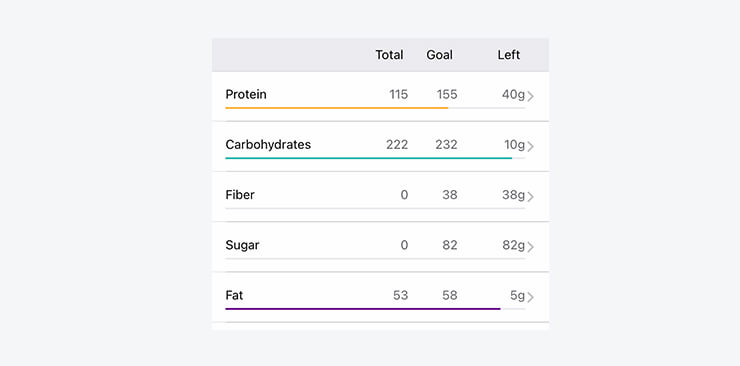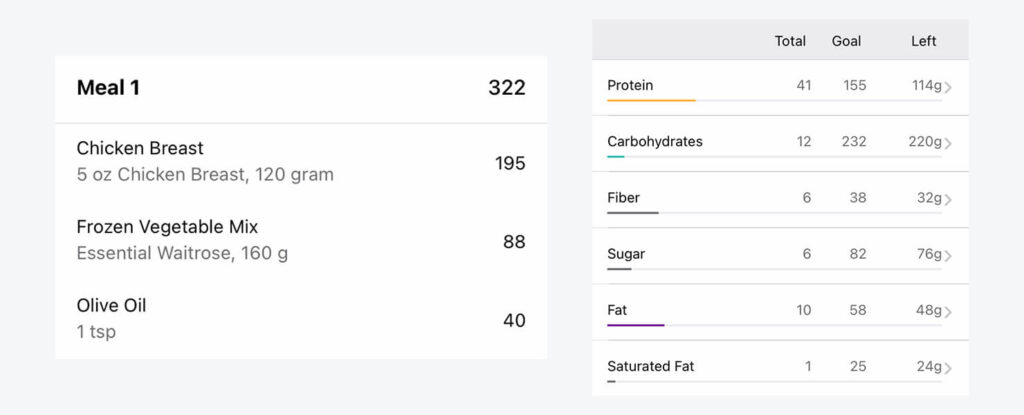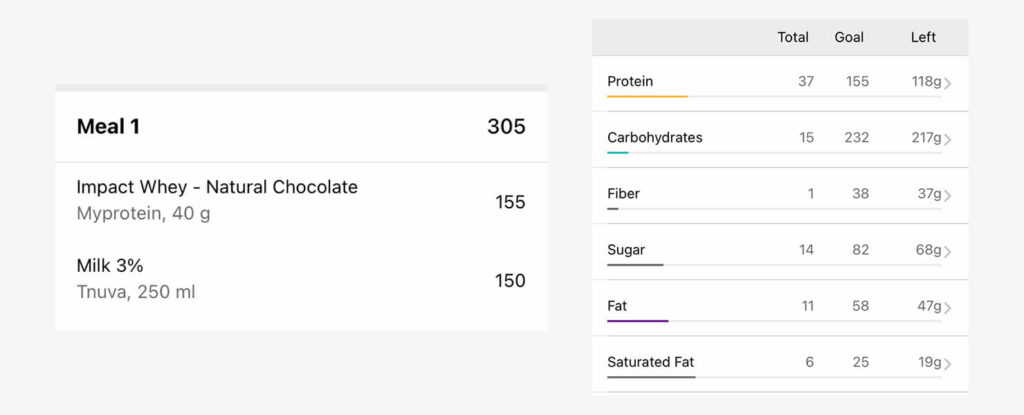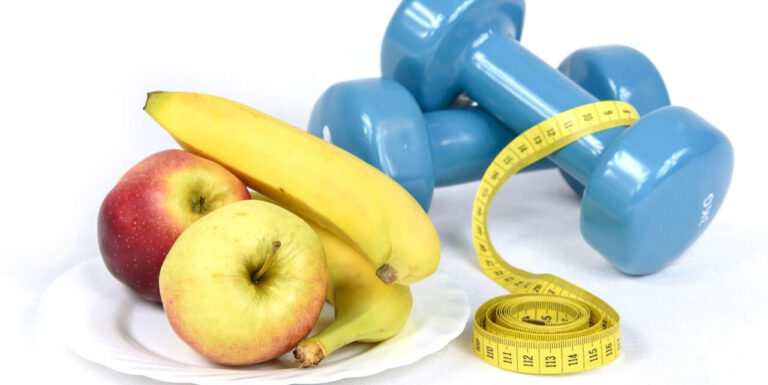How To Hit Your Macros Consistently (Step-by-Step Guide)
Are you struggling to hit your macros? Whether you’re trying to lose weight, gain muscle, or just maintain your current physique, hitting your macros is essential.
In this step-by-step guide, I’ll cover everything from calculating your macros and creating a meal plan to measuring food and tracking macros accurately to ensure you’re consistently hitting your macronutrient targets. Moreover, I will share a few tips on how to hit your macro goals if by the end of the day you’re still short on one or more macronutrients.
Jump to sections:
- Why Is Hitting Your Macros So Important?
- 6 Steps To Hitting Your Macros Consistently
- Best Practices for Hitting Your Macros at the End of the Day
- Frequently Asked Questions About Hitting Macros
Why Is Hitting Your Macros So Important?
You probably already know that macros are short for macronutrients. These are the three nutrients that make up the calories in the food we eat:
- Protein
- Carbohydrates
- Fat
All foods contain some combination of these three macronutrients.
But why bother counting macros?
Well, the answer is simple.
If you want to lose fat, build muscle, improve performance or just improve your overall health, hitting your macros in the right ratio is essential due to the following reasons.
Each macronutrient plays a specific role in the body:
- Protein is used to build and repair muscle tissue.
- Carbohydrates are used for energy.
- Fat is used for a variety of things, including hormone production and supporting cell function.
When it comes to improving your body composition (i.e., losing fat or gaining muscle) or performance, hitting your macros is important for the following reasons:
- If your goal is to lose fat, you need to be in a calorie deficit, which means eating fewer calories than you burn. To do this without losing muscle mass, you will also need to make sure you’re consuming enough protein.
- If your goal is to build muscle, you need to be in a calorie surplus, which means eating more calories than you burn. To do this without gaining too much body fat, you need to be in a small calorie surplus, and consume enough protein as well as calories from carbohydrates to support your training.
As you can see, in both cases, protein is essential. But the right ratio of other macronutrients also matters and will vary depending on your goals.
This is why it’s so important to hit your macros consistently. By doing so, you ensure that you’re providing your body with the right nutrients in the right ratio to support your goals.
6 Steps To Hitting Your Macros Consistently
1. Determine Your Calorie Target
The first step is to determine how many calories you need to eat each day.
You can use an online TDEE calculator to estimate how many calories you burn in a day.
Additionally, you can test whether the estimate is accurate by eating a set number of calories and tracking your weight for a few weeks. If you’re not losing or gaining weight, it’s likely that the estimate is accurate. Otherwise, you can adjust your calorie target up or down until you find a number that allows you to maintain your weight.
Alternatively, you can track your food intake for a week or two while weighing yourself every day without estimating it using a calculator. From there, you can adjust your calories up or down until you find the intake that allows you to maintain your current weight.
This is your starting point.
Then if you want to lose fat, you will need to eat fewer calories than this. Usually, a deficit of 20-25% calories is a good place to start. This will allow you to lose weight at a recommended rate of 0.5-1 kg (1-2 pounds) per week (1).
On the other hand, if you want to build muscle, you will need to eat more calories than your TDEE. It’s recommended that novice/intermediate athletes should have a caloric surplus of about 10 – 20%, and aim for a target weight gain of about 0.25 – 0.5% of body weight per week (2). While advanced athletes should aim for half that of novice/intermediate athletes – approximately 5 – 10% calorie surplus and a target weight gain of about 0.15 – 0.25% of body weight per week (0.5 – 1% per month).
If you are curious to learn more about this topic then check out the article on bulking weight gain per week.
2. Determine Your Macronutrient Targets
Now it’s time to determine your macronutrient targets.
There are a few different ways to do this.
You can use a manual approach – meaning you calculate your macronutrient intake based on the number of calories you’re eating yourself, using the macros ratio that you want to hit, and making calculations from there. Or you can use an online macro calculator.
Here are the resources that explain how to calculate your macros depending on your goal:
- If your goal is to lose fat find out how to calculate cutting macros here.
- If your goal is to build muscle see how to calculate lean bulking macros in this article.
Both articles include a macro calculator that you can use to determine your specific macronutrient targets, as well as a manual method to help you understand the calculations.
3. Create Balanced Meal Plan
Following a balanced meal plan is by far the best way to consistently hit your macros.
It takes all the guesswork out of what to eat and in what quantities.
And, it does not have to be boring. You can have 3-4 variations of each meal (breakfast, lunch, dinner and snacks) that all have a similar macronutrient content, and that you enjoy eating.
However, if you want to hit your macro targets but don’t want to follow a meal plan, instead you prefer a more flexible approach, then you need to be very mindful of what you’re eating and track everything meticulously. More on this later.
The way you create a meal plan is by first determining how many meals you want to eat per day and then creating recipes or finding existing ones that fit your macronutrient targets.
When building your meal plan I recommend creating meals around a protein source. Then you can add in healthy fat and/or carb sources to reach your target macros for that meal.
To make things easier for you, you can use a macro meal planner. This will do all the hard work for calculating your calories and macros as you input your food items and create your meals.
4. Try to Meal Prep Your Meals Ahead of Time
Another thing that can help you hit your macros consistently is to prepare your meals ahead of time. This will help you stay on track and make it less likely that you’ll make poor food choices when you’re hungry.
There are a few different ways that you can prepare your meals:
- You can cook all your meals for the week in one day, or just a few days in advance. Then portion them out into containers, and store them in the fridge.
- You can cook individual ingredients ahead of time, and then combine them when you’re ready to eat. For example, you can cook a batch of chicken breasts, then portion them out and store them in the fridge. Then when you’re ready to eat, you can combine them with other ingredients to create a meal.
- You can also batch cook recipes and then freeze them in individual portions. This is a great option if you don’t have a lot of time to cook during the week, and it will also save you some money.
- You can cook each meal as you need it.
- Lastly, you can find premade meals that fit your macros through some meal prep companies. However, these can be expensive, and you will have to do research to find a reputable company that makes meals that would fit your macros and taste good. But as far as convenience goes (after you find a good company), this option is hard to beat.
No matter what method you choose, the important thing is that you have healthy meals that fit your macros and are readily available so that you can stay on track.
5. Measure Your Meal Portions
Next, you will have to make sure you are accurate with your food measurements.
This means measuring out your food portions with a food scale, and not eyeballing it.
I know it sounds like a lot of work, but it’s important to be precise if you want to hit your macro goals as accurately as possible.
A lot of people think that they can eyeball their portions and get close enough, but the truth is that it’s very easy to underestimate how much food you’re eating. And even a small underestimation can add up over the course of a day, week, or month.
So, to avoid this, invest in a digital food scale and take the time to measure your food portions. It will save you a lot of time and hassle in the long run.
Some might use measuring cups, but these can also be inaccurate – a digital food scale is the best way to measure your food portions.
I recommend you check out the video below to see how results using measuring cups can differ from using a food scale.
6. Log Your Meals Before You Eat Them
Finally, after you measure your food portions, you will want to log your meals into a food tracking app. You could skip this step if you follow your meal plan perfectly (assuming it is set up properly). But definitely should not skip this step if you prefer following a more flexible dieting approach like IIFYM (If It Fits Your Macros).
As you track your meals, you will be able to see how many calories and macros you have left for the day and make adjustments accordingly.
There are many different food tracking apps that you can use, one of my personal favourites is MyFitnessPal.
Another alternative to a tracking app is a calorie tracker spreadsheet like this one. I recommend using it if you have a handful of foods that you eat regularly. It allows you to simply select specific food items from drop-down menus. Then, you will have to input how much of each food item you want to eat, and it will calculate the calories and macros for you.
Using such a tool can help you avoid discrepancies between the nutritional information registered in the tracking app database and the actual amount of calories and macros you’re consuming.
This is because many tracking apps rely on user-entered data, and sometimes this data can be inaccurate. Which is one of the main reasons why people find themselves hitting their macros but not their calories.
Plus, using a calorie tracking template you will always be able to modify and update it with new foods and their exact macronutrient information. You can learn more about the calorie tracker spreadsheet here, as well as download it for free.
Best Practices for Hitting Your Macros at the End of the Day
Imagine that it’s almost the end of the day, and you’re about to go to bed but still have some macros left. You check your calorie tracker and see that you’re 30 grams short on protein, 10 grams on carbs, and 5 grams on fat.

What do you do?
First of all, don’t panic. It’s not the end of the world if you don’t hit your macro goals perfectly every single day.
Here are a few things you can do to make sure you reach your macro intake goals before the end of the day.
Familiarize Yourself With Foods and Their Macros
First, to make things easier on yourself, it’s a good idea to familiarize yourself with the macros of different foods.
This way, you will know what foods you can eat to hit your macros without having to look up the nutritional information every time.
For example, if you know that a chicken breast has 27 grams of protein. So, in the example mentioned above, you would need to eat just one chicken breast together with some vegetables and perhaps some salad dressing.
I recommend you use a macro cheat sheet to help you familiarize yourself with the macros of different foods. You can also download it in PDF format for free.
Opt for Single-Macros Foods
Somewhat similar to the point above, another helpful strategy is to focus on eating foods that contain mostly one macro.
For example, if you need to eat more carbs, you could have a sweet potato or a bowl of oatmeal. Both of these foods are mostly carbs with very little fat and protein.
Or, if you need to eat more fat, you could have some avocado, nuts or nut butter. These foods are mostly fat with very little carbs and protein.
Although it makes things simpler, this doesn’t mean that you should eat only foods that contain mostly one macro. You can (and should) mix things up depending on the macros you need to hit, but it’s good to have a few staple single-macro foods that you know you can eat to help you reach your macro targets. Especially when you see that you’re short mostly on a specific macronutrient.
Prioritize the Largest Remaining Macronutrient Target
If you’re close to reaching your daily macro goals but still need to eat more, it’s a good idea to first focus on the macronutrient you’re the furthest away from hitting.
As an example, let’s say you need to eat 40 grams of protein, 15 grams of carbs, and 10 grams of fats to reach your macro targets.
In this case, you would need to make sure to eat a source of protein first, because that’s the macronutrient you’re furthest away from hitting.
You could have chicken breast with some veggies cooked in a bit of olive oil.

Or a large protein shake with full-fat milk.

Ensure You Hit Your Protein First
Another best practice is to make sure you hit your protein macros first, before being close to hitting your other macros.
The main reason is that most people tend to be short on protein, especially if they’re new to fitness and tracking macros.
It’s also important to priortize protein because it is an essential nutrient to support your body and muscle growth.
A good general rule to follow is to build your meals around a source of protein first, and then add carbs and fat to hit your macros.
For example, let’s say you need to eat 40 grams of protein, 30 grams of carbs, and 10 grams of fat.
A good meal option and a thought process you could follow would be the following:
- 40 grams of protein: chicken breast
- 30 grams of carbs: a cup of rice
- 10 grams of fat: olive oil and some from chicken breast
Don’t Overthink About Hitting Macros to the Gram
If you’re new to tracking macros, it’s easy to get caught up in the numbers and try to hit your macro goals perfectly to the gram.
However, this is unnecessary and it’s actually not that important.
A general rule of thumb is to be within +/- 5 grams of your macros for the day.
So, if you’re supposed to eat 40 grams of protein, it’s not a big deal if you end up eating 38 or 42 grams.
The same goes for carbs and fat. Just like you saw in my meal examples above.
The main thing is to make sure you’re consistently reaching your macros day in and day out in a range that’s close enough to your targets, and the rest will take care of itself.
Of course, this is just a general rule and there will be situations where you’ll want to be more precise (e.g. if you’re trying to lose fat and are preparing for a bodybuilding competition).
Frequently Asked Questions About Hitting Macros
How Do You Hit Your Macros Perfectly?
You can ensure you reach your macro targets as close as possible by weighing and measuring your food, using a calorie tracker, and/or being mindful of the macro content of the foods you’re eating. But remember, it’s not necessary to hit your macros perfectly to the gram. A general rule of thumb is to be within +/- 5 grams for each macronutrient. Most importantly, you should focus on being consistent with your macro intake day in and day out.
What Happens if I Don’t Hit My Macros?
If you don’t hit your macros, it’s not the end of the world. Just try to be as close as possible and don’t stress about it too much. The most important thing is to be consistent with your macro intake day in and day out. If you don’t hit your macros one day, then just adjust and try to hit them the next day.
How Close Is Hitting Your Macros?
A general rule of thumb is to be within +/- 5 grams of each macronutrient. So, if your daily protein intake is supposed to be 140 grams, it’s not a big deal if you end up eating 138 or 142 grams. Just try to be as close as possible and be consistent with your macro intake on a daily basis.
Final Thoughts
Tracking your macros is a great way to ensure you’re consistently hitting your nutritional goals.
In this article, I’ve outlined a step-by-step process on how to hit your macros, as well as some best practices to follow when you struggle to reach your macros at the end of the day.
Just remember to be consistent with your intake and don’t stress too much about being precise to the gram, and you’ll be on your way to reaching your goals.
References
1. Helms ER, Aragon AA, Fitschen PJ. Evidence-based recommendations for natural bodybuilding contest preparation: nutrition and supplementation (2014). Retrieved from https://pubmed.ncbi.nlm.nih.gov/24864135/
2. Iraki J, Fitschen P, Espinar S, Helms E. Nutrition Recommendations for Bodybuilders in the Off-Season: A Narrative Review (2019). Retrieved from https://www.ncbi.nlm.nih.gov/pmc/articles/PMC6680710/





